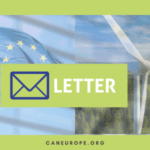The EU’s renewable energy Directive (RED) sets the framework for the EU in deploying renewable energy across all sectors in the Member States with the overall goal of increasing the EU’s renewable share. After long and difficult negotiations, the RED is entering its final stages for adoption and Europe’s renewable energy transition to take off.
On the 16th June, EU Member States finally came to an agreement on the RED revision. This came after weeks of France refusing to accept the compromise agreement reached by the Council and the European Parliament at the end of March. After the blockage from France came to an end, the RED revision can now finally go through the last stages of adoption. So once fully adopted, what will it bring?
Ambition too low
In the global fight against the climate crisis, urgent action this decade is critical to ensure the Paris Agreement objective of limiting global temperature increase to 1.5°C by the end of the century remains attainable. The EU must do everything in its power to further accelerate emission cuts in the near future and achieve at least 65% greenhouse gas emission reduction by 2030 and climate neutrality by 2040 at the latest. To be in line with the Paris Agreement, we need an EU binding renewable energy share of at least 50% by 2030.
Even though the European Commission proposed an EU renewable energy share of 45% by 2030 (as part of the REpowerEU package), the final compromise on the RED revision is only proposing an EU 2030 binding renewable energy share of 42,5% with an additional indicative top up of 2.5%. Not only is the binding 42.5% target too low in ambition, it is also still not clear how the additional top up will be achieved. Member States are about to submit their draft updated National Energy & Climate plans (NECPs) by the end of this month, including a national renewable energy contribution. Is the European Commission betting that the sum of the national renewable energy contributions will overshoot the binding 42,5%? That is a risky thing to do. As there is no time to lose, the European Commission should come with additional proposals that guarantee the additional top up will in any case also be achieved.
RED should be for renewables only
Since the beginning of the RED revision process, there have been efforts to include low carbon fuels and non renewable energies into the RED. Even though there have been strong protests from the beginning, France (supported by some other Member States) held Europe’s renewable energy transition at ransom by looking to undermine the RED through including low carbon sources until the bitter end. This led to too many concessions within the negotiations, which could negatively affect the renewable hydrogen subtarget for industry and risk facilitating hydrogen based on nuclear.
These concessions to France risk undermining Europe’s energy transition by taking away crucial resources and funds from the deployment of renewables. The RED has provenmeffective in driving down the costs of renewable energy technologies and fostering investments in renewables assets across Europe.
Acceleration of renewable energy
The RED revision is including new provisions on spatial planning and mapping. These new provisions can create more clarity where renewable energy projects can be developed and contribute to more stable and predictable conditions for investments in renewable energy projects. Based on the results of these mapping exercises, Member States must designate renewables acceleration areas where renewable energy projects would undergo simplified and fast permit-granting processes. In the case that nature protection and effective engagement of citizens and local communities are guaranteed, the new permitting provisions can provide an important basis for quicker deployment of renewable energy projects.
Not enough guarantees for sustainable bioenergy
New provisions on bioenergy have been added to the RED as well. Unfortunately they are not strong enough to ensure bioenergy will deliver significant, near-term greenhouse gas savings compared to fossil fuels, that limited sustainable biomass resources will be optimally used in the wider economy and within the energy sector, and that biomass burning does not lead to a further increase in air pollution and biodiversity loss.
What next?
There are 6 and a half years to go by 2030 and time is running fast. The RED revision is offering a framework that can support an accelerated deployment of renewable energy, but it is now up to the Member States to ensure this framework is translated into concrete measures that will support a faster energy transition.
By the end of this month, Member States need to submit their draft updated National Energy and Climate Plans. These updated NECPs should include national contributions to the overall EU climate and energy targets for 2030, including national contributions to the overall EU renewable energy share. As highlighted in a recent report by the European Court of Auditors (ECA), more support will be needed to ensure effective policies will lead to achieving more ambitious EU targets. The EU reached its 2020 renewable energy target, but this was only possible due to a number of external factors, including the halt of economic activity due to the COVID-19 pandemic in 2020. The ECA is recommending that more transparency is needed on the performance of the EU and its Member States on climate and energy action. The draft NECPs will be the first test to assess whether Member States are now serious about the energy transition and addressing the global climate emergency.



